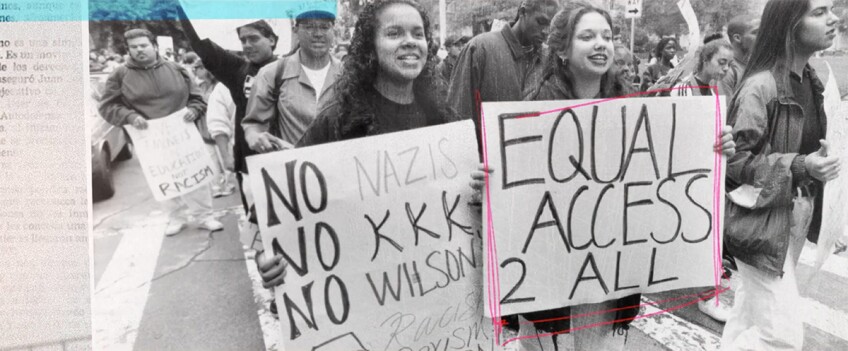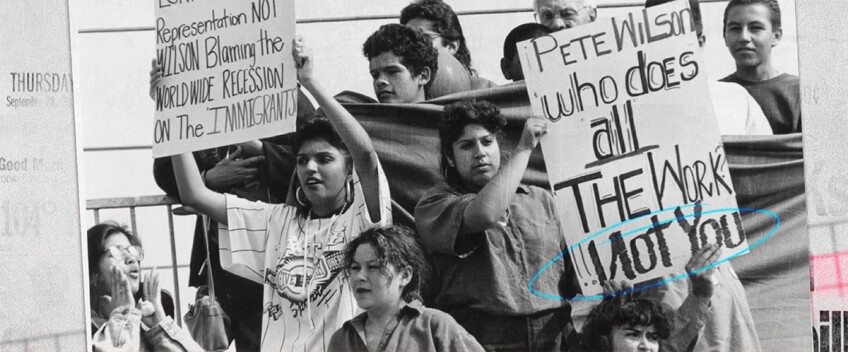The Fight is Far from Over: Prop 187, a New Jim Crow and Immigration Today

Prop 187, an anti-immigrant proposition introduced and passed in California in 1994, is an important lesson about the strength of a galvanized Latino electorate. But another no-less crucial lesson from Proposition 187 is the need for continued vigilance against important political repercussions that have come to define the 21st-century immigration policy landscape.
Learn more about this anti-immigrant ballot and the resulting effects in history on "187: The Rise of the Latino Vote." Watch now.
Prop 187 opened another viable venue for the immigration fight: state and local politics
Prop 187 passed with almost 60% of the vote and its victory opened another viable venue for the immigration fight: state and local politics. After the passage of Prop 187, Barbara Coe and Ron Prince, leaders of the “Save Our State” campaign, worked with similar groups in other states to introduce some version of Prop 187 around the nation. Within a decade of the passage of Proposition 187, four other states considered these copycat laws. However, these main proponents of 187 failed to recreate their victory two years later, unable to gain enough signatures to put a "Save our State II" proposition on the November 1996 ballot. Despite these losses, they were still in demand by other restrictive immigration state entrepreneurs to pass Prop 187 laws in other states. Other restrictive immigrant groups have recently consulted the same Prop 187 playbook to expand the restrictions against noncitizens. Prop 200 was introduced in 2004 in Arizona by a community group called “Protect Arizona Now.” The initiative was a response to the patently false claim that undocumented immigrants were voting in state and federal elections en masse. Proposition 200 required would-be voters to show a state driver’s license, birth certificate or passport to register to vote and charged public officials with a misdemeanor if they failed to report welfare applications unable to supply citizenship documentation.
Prop 187 informed later federal immigration policy
Even with Proposition 187 mired in lawsuits following its victory, national anti-immigrant advocates saw this as a clear signal of opportunity. They saw that even in one of the most liberal states in the Union, a constituency of voters existed who supported restrictive immigration policy. Furthermore, the win emboldened federal bureaucrats who used the Prop 187 victory as a metric for the popularity of restrictive immigration policy. Some of its central ideas and justifications were included in congressional debates and policies that make up the Illegal Immigration Reform and Immigrant Responsibility Act of 1996 (IIRAIRA) and the Personal Responsibility and Work Opportunity Reconciliation Act of 1996 (PROWA). These two pieces of legislation fundamentally changed the lives of noncitizens in the United States, and the influence of Proposition 187 is prominent. IIRAIRA increased the number and severity of crimes and penalties associated with being undocumented in America. It also included the language for what would become the 287(g) program where state and local police officers can collaborate with the federal government to enforce federal immigration laws. PROWA restricted many federal, state and local public benefits to undocumented immigrants and increased the difficulty for undocumented students to receive in-state tuition benefits public universities.
Before the passage of these two seminal federal immigration policies, national legislators took the restrictive mandates established and justified by Proposition 187 and began attempting to implement them at the federal level. In 1995, Texas House Representative Lamar Smith introduced the Immigration in the National Interest Act of 1995 with 100 bipartisan cosponsors. Most of these sponsors were House Representatives from California. Conservative politicians previously opposed to 187 doubled back on their previous positions in support of restrictive immigrant policies.
Two years after Proposition 187 was passed, its provisions related to immigrants became part of Clinton's 1996 Welfare Reform Act. Restrictive immigration entrepreneurs had effectively created a "back door" of sorts to make federal immigration policy using the combination of federalism, and the skills, knowledge and connections learned during the Prop 187 experience. Their efforts changed norms about the means and ends of immigration policy. Where before federal immigration policy was the means to reduce the pull factors of migrants, like employment, the post-187 world opened the possibility for individual state-level restrictive immigrant policies with respect to housing, education, and policing.
The three main goals of the finalized IIRAIRA and PROWA included similar, if not the same, provisions and objectives of Proposition 187: increasing securitization of the border using force and policing tactics and reducing the forms of legal entry. The third goal of Proposition 187 was attrition-based interior enforcement like prohibiting access by noncitizens to state and local benefits like nonemergency health care and access to public schooling. The federal government followed suit in the 1996 Personal Responsibility and Work Opportunity Reconciliation Act, where it barred legal immigrants from accessing public health and welfare assistance for five years. By 1996, the federal government had prohibited access to undocumented immigrants as much as they could within the laws. Undocumented populations were still increasing in traditional destinations and new places like the Midwest and the Deep South. The battle at the federal level was mostly over, but the war of attrition still required attacks at the subnational level.

Prop 187, “Juan Crow” and a war of attrition
Proposition 187 was a success despite its constitutional invalidity. Prop 187 had succeeded in passing legislation in California — a new, smaller (relative to the federal government) arena. Prop 187 had passed in a state that had gone to Clinton in the presidential election two years before, whose undocumented population was the largest in the nation and was significantly Latino and Asian. Future restrictive immigration entrepreneurs, in other states, would replicate the policy strategy used by the authors of Prop 187. Since then, restrictive immigration advocates have used state legislatures as the vehicles to enact their vision of immigration policy, one state at a time. Studies executed before Prop 187 on state immigration policy formation focus on the importance of business or political interests or demographic changes. Further investigations on 187’s strategy add to that body of knowledge by explaining the importance of issue entrepreneurs in creating and introducing immigration policy at the state level. In essence, Prop 187’s strategy encouraged the tactic of "greasing the machine" with their expertise and political connections, facilitating the creation and introduction of immigration policy at the state level.
The word “attrition” comes from the Latin root atterere, literally to "grind down" an opponent. Restrictive immigration legislation has become an attempt to implement a war of attrition against undocumented immigrants, to subject them to personal and material losses to the point of "defeat" (i.e., deportation or leaving). The Arizona legislature introduced a restrictive immigration bill in 2010 that specifically established a state policy of "attrition through enforcement" with many other states following suit.
By 1996, the federal government had prohibited access to undocumented immigrants as much as they could within federal laws. Still, undocumented populations were increasing, but now, not only in traditional destinations but in new places: the Midwest and the Deep South. The battle had been fought at the federal level, but the war of attrition required a sustained attack at the local level. It was a war against undocumented immigrants only possible at the state and local level. State and local authorities are more diffused, more numerous and coming into more frequent contact with undocumented immigrants. Making the war of attrition a state and local mandate increases its success as participating in federal level policymaking becomes too big, too complex and too costly.

The main template of these state-level immigration attrition laws was state and local Jim Crow legislation introduced during Reconstruction. These laws established and enforced racial segregation and Black voter disenfranchisement in the United States from Reconstruction to the mid-20th century. State and local policies like sun-down towns/states, prohibiting Black Americans from sitting on juries and the de jour disenfranchisement of Black voters were just some of the laws enacted to ostracize and disempower Black citizens, not only in the South but across the entire United States. To this day, the legacy of the unfathomable power asymmetries created by slavery and later Jim Crow laws has disadvantaged Black communities economically, civically and politically. In 2008, Roberto Lovato coined the neologism "Juan Crow" to equating these Jim Crow power asymmetries with contemporary state and local immigration policy. Lovato argued that much like the old John Crow, the result of Juan Crow was the mass incarceration of noncitizens. Like Jim Crow, the state anti-immigrant laws create economic oppression and racial and ethnic hostility and threatens to calcify noncitizens into an economic, political and civic underclass.
Lovato’s concept of Juan Crow highlights the similarity in the venue change of the immigration fight as well. As we have been experiencing federal inaction on immigration policy, the policymaking arena has lowered to the state and local level. Further, we have experienced an increase in the number and severity of restrictive immigration legislation in these subnational venues. It is easier for small groups of intense partisans to introduce and pass restrictive immigration at the state and local level as the barriers to entry are considerably lower than the federal level with a higher chance of success.
Proposition 187 in California was a critical case study in state immigration policy for several reasons. It was a definitive win for California's progressive immigration policy, even though it won the popular vote. But it would be shortsighted to think the immigration issue in California, or any state, as a “done deal.” Other policy issues like abortion and voting rights were thought long solved, only to be constantly met with opposition from new venues and with new justifications. Those who experienced Prop 187 have a responsibility to share their expertise to empower other communities to stay vigilant against new policies that threaten immigrant rights.
Top Image: A few frames of 187 protests | Still from "187"


